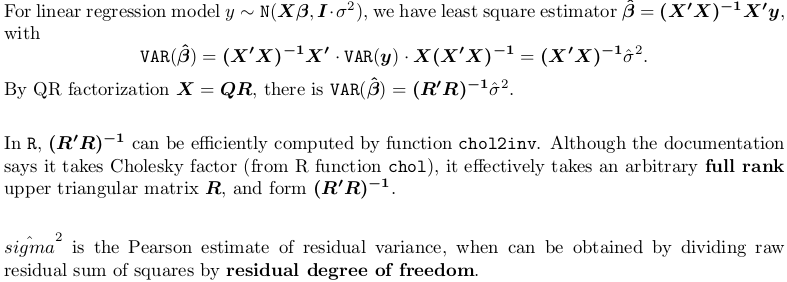setup (copying in your code)
y <- iris$Sepal.Length
x <- iris$Sepal.Width
X <- cbind(1,x)
n <- nrow(X)
p <- ncol(X)
qr.X <- qr(X)
b <- (t(qr.Q(qr.X)) %*% y)[1:p] ## can be optimized; see Remark 1 below
R <- qr.R(qr.X) ## can be optimized; see Remark 2 below
beta <- as.vector(backsolve(R, b))
res <- as.vector(y - X %*% beta)
math
![enter image description here]()
computation
Residual degree of freedom is n - p, so estimated variance is
se2 <- sum(res ^ 2) / (n - p)
Thus, the variance covariance matrix of estimated coefficients is
V <- chol2inv(R) * se2
# [,1] [,2]
#[1,] 0.22934170 -0.07352916
#[2,] -0.07352916 0.02405009
validation
Let's check the correctness by comparing with lm:
fit <- lm(Sepal.Length ~ Sepal.Width, iris)
vcov(fit)
# (Intercept) Sepal.Width
#(Intercept) 0.22934170 -0.07352916
#Sepal.Width -0.07352916 0.02405009
Identical result!
Remark 1 (skip forming 'Q' factor)
Instead of b <- (t(qr.Q(qr.X)) %*% y)[1:p], you can use function qr.qty (to avoid forming 'Q' matrix):
b <- qr.qty(qr.X, y)[1:p]
Remark 2 (skip forming 'R' factor)
You don't have to extract R <- qr.R(qr.X) for backsolve; using qr.X$qr is sufficient:
beta <- as.vector(backsolve(qr.X$qr, b))
Appendix: A function for estimation
The above is the simplest demonstration. In practice column pivoting and rank-deficiency need be dealt with. The following is an implementation. X is a model matrix and y is the response. Results should be compared with lm(y ~ X + 0).
qr_estimation <- function (X, y) {
## QR factorization
QR <- qr(X)
r <- QR$rank
piv <- QR$pivot[1:r]
## estimate identifiable coefficients
b <- qr.qty(QR, y)[1:r]
beta <- backsolve(QR$qr, b, r)
## fitted values
yhat <- base::c(X[, piv] %*% beta)
## residuals
resi <- y - yhat
## error variance
se2 <- base::c(crossprod(resi)) / (nrow(X) - r)
## variance-covariance for coefficients
V <- chol2inv(QR$qr, r) * se2
## post-processing on pivoting and rank-deficiency
p <- ncol(X)
beta_full <- rep.int(NA_real_, p)
beta_full[piv] <- beta
V_full <- matrix(NA_real_, p, p)
V_full[piv, piv] <- V
## return
list(coefficients = beta_full, vcov = V_full,
fitted.values = yhat, residuals = resi, sig = sqrt(se2))
}

